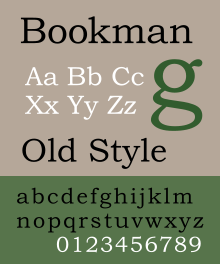Bookman (typeface)
 |
|
| Category | Serif |
|---|---|
| Classification | Transitional |
| Designer(s) | Alexander Phemister Chauncey H. Griffith Ed Benguiat |
| Foundry |
Bruce Type Foundry American Type Founders Lanston Monotype |
| Date created | c.1858 |
| Design based on | Old Style Antique |
| Shown here | Bookman Oldstyle by Monotype Imaging |
Bookman or Bookman Old Style is a serif typeface. It evolved from derivatives of the "Old Style" design created by Alexander Phemister around the 1850s for the Miller & Richard foundry. It is particularly associated with the graphic design of the 1960s and 1970s, when revivals of it were very popular.
Bookman (as it became) was designed as an alternative to Caslon, with a more even and regular structure, a wide and tall lower-case, little contrast in line width and considerably greater weight, almost to the point of being a slab serif. It maintains its legibility at small sizes, and has been used extensively for headlines and in advertising.
The ancestor of Bookman Old Style is Miller & Richard's "Old Style" cut by Alexander Phemister. Sometimes called a "modernised old style", it is a redesign of true old-style serif faces from the eighteenth century such as Caslon with a quite wide design and larger lower-case letters. It became popular in the USA and one of a wide range of loose revivals and adaptations of the Caslon design, visible in the wide-spreading arms of the T and the sharp half-arrow serifs on many letters.
The direct ancestor of Bookmans were several fonts from around 1869 named "Old Style Antique" somewhat bolder than Miller & Richard's first old-styles. "Antique" was a common name given to bolder typefaces of the time, now often called slab serifs, and identifies the aim of creating a complementary bolder design on the oldstyle model for uses such as emphasis. However, the oldstyle antique designs then became used for body text. Although old-style antiques were bolder than the original old-style face, the difference was not great enough that they could not be used for body text.
G. Willem Ovink, a historian of type, writes in his history of the style in 1971 that:
A bold Old Style was needed. This was indeed produced, almost simultaneously in Philadelphia and in Edinburgh [around 1869] in two distinct designs, both under the name of Old Style Antique. The term 'Antique' probably refers less to historical forms than to the boldness and the stubby serifs of the Egyptians, which were also called antiques. In the 1890s, when such faces as Caslon and Jenson had introduced the notion that all historic romans were bold, their colour and old-style basic forms made the old-style Antiques in the words of De Vinne...'now often used as fair substitutes for older styles of text types,' regardless of their unhistoric origin. The course of development is difficult to trace."
...
Wikipedia
